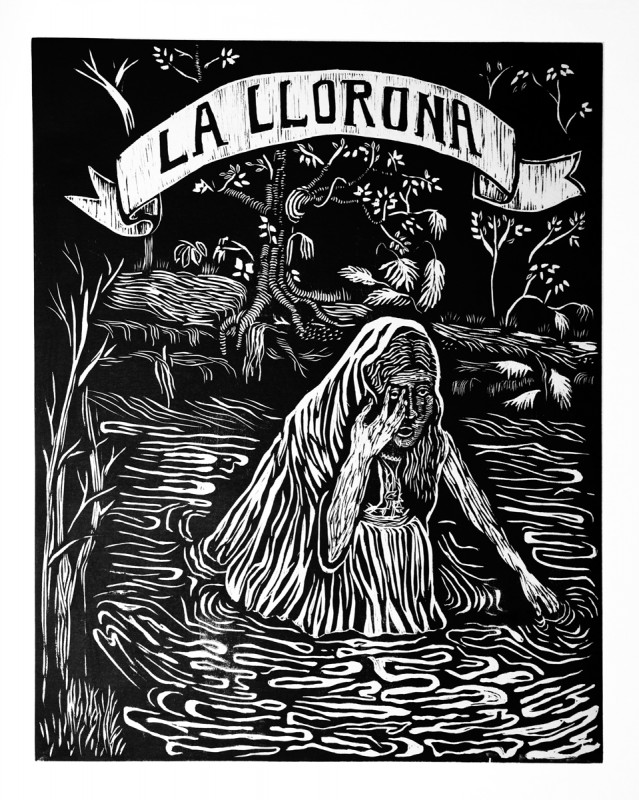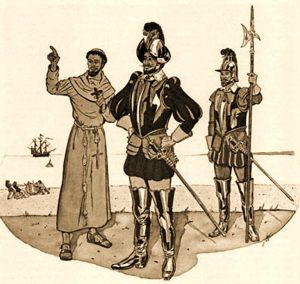There she is, hair black as night with a dress on as white as snow, but for some reason you can’t get a good view of her face. Then, all of sudden, she’s in yours, screaming at the top of her lungs. This is not your typical girl, and although she may sound like one, she is much worse. What you just witnessed is a mother grieving for her children. Some might question her parental instincts, but she only killed them for love, and let’s be honest, love makes you do some crazy things. If you are wondering who I am talking about, the woman I am referring to is La Llorona, who also answers to the name weeping woman.
The story is about a beautiful lady who fell in love with a man. They got married and had children, but sadly the husband died and left the lady to raise their children alone. Even with the struggles of raising her children alone, she found love again with another man. Everything was going great between them, until he found out that she has children. Furious with her, he left her for another woman. Anger and despair filled her heart and her mind, so she blamed her children for ruining what she wanted the most. She believed that if she could get rid of the children, he would come back to her. So she took her children to the river, where she drowned them. But shortly after she realized what she had done, she became horrified at herself. With a broken heart, forever after she then went on in life, mourning for the loss of her children. After her death, it is said that she lures people away to kill them in the hope of finding her lost children.1

This story dates back for centuries, starting before the Spanish Conquest. During that time period, the story is that an Aztec emperor had heard a woman’s cries and asked a nearby priest what it meant. The priest replied, saying that the cries were from the goddess Cihuacoatl, and her cries were one of the eight omens of doom. These omens began manifesting during the ten years before the arrival of Cortes in 1519. Cihuacoatl is the Aztec goddess who supposedly steals children away from their mothers and fathers, then later on sacrifices them.2
In other related stories of La Llorona, the woman isn’t known as La Llorona, but rather as La Malinche, the Indian mistress of Cortes. In this version, she doesn’t weep because of the loss of her children, but instead weeps because she betrayed her people to the conquerors.3 Cortes was the Spanish conquistador and Malinche was sold to him as a slave, but over time she was willing to help him on several adventures, but by doing this, she turned against her people. Although no known children were killed, she does appear to have had children with Cortes. This is where the origins of the legend gets confused on which culture actually created La Llorona. There are rumors saying that the Spanish may have gotten the origins confused with one of their own native legends.4 Regardless of where the story was first heard, the documentation of La Llorona appeared around 1550.5 Over time, the myth of La Llorona has been adapted to different customs and traditions, but each adaptation continues to recount five stable elements: a woman, a white dress, weeping for lost children, wandering, and water.
In other versions of the story, Llorona is simply a woman who drowns her children. English-language versions of the story simply call the woman the weeping woman, with her white dress symbolizing her link to the spiritual world as a ghost. In most of her stories, children do die; therefore, she weeps for them regardless of how they may die. While wandering and water are separate story elements, they go hand in hand in each adaptation. The Weeping Woman will always be wandering to find her drowned children, no matter where the story is told. This is why parents in the American south-west ( in California, Arizona, Colorado, Texas, and Mexico) warn children not to stray away, be naughty, or go out after dark, because they believe if the Weeping Woman is out there wandering, she could find you.6 Not only does she wander everywhere, but she typically will wander near bodies of water. This creates yet another warning that parents impart to their children, believing that water is dangerous and unpredictable. To prevent children from going near water without an adult, they tell their children the tale of La Llorona.
But it’s not just children that she goes after, but rather everyone. Typically, it’s more common for her to go after men than women, because it was a man who drove her to kill in the first place. So she uses her broken heart to get revenge on men because of how betrayed she feels.7 She uses her weeping to lure men to her, then kills them shortly afterwards. Since it is more common for males to be lured away, there are lessons for boys, namely, that the tale suggests to boys that women are temptresses of malevolent sexuality that can cause them to lose their souls as well as control of their bodies.8 While women aren’t primarily targeted, La Llorona can also teach young girls lessons as well, namely, that girls should be careful not to fall for a young man who may have wealth and nice clothes, but who is too far above them to consider marriage.9 Although it may seem unfair to women, overall the tale is meant to protect young ones from disobedience and to guide them in proper behavior. Since the story revolves around a woman, it is common for mothers and grandmothers to tell the Weeping Woman tale. Since the story is more typically shared by women rather than men, women used this to create an adaption in La Lloronas tale. Most females believe that La Llorona is a fragile woman, giving the impression that females are victims. So by evolving her story, they can adapt La Llorona to seem strong and powerful.

In Seguin, Texas you will find a place called Woman Hollering Creek, which crosses Interstate 10 near San Antonio, Texas. It is here where the story changes from one depicting a grieving mother to a survivor. In this version, the woman is a young bride in a white dress. But instead of being left behind by a man, she is beaten and has a miscarriage. The creek goes along her house, so she wanders along it while her husband is away at work. Later on in her life she gives birth, and it was at that point where she conjures up images of La Llorona.10 In this version, it still manages to have all the key elements of La Lloronas story. The white dress because she is a female bride, the weeping for children because she had a miscarriage, the Woman Hollering Creek being her source of water while wandering around it. However, instead of weeping and longing for children for eternity, she uses her voice in other ways. The Woman Hollering Creek story has her gaining her voice as a sign of rejection from domestic abuse. Although it may be completely different from most known stories, this one has became popular in the female world. With La Lloronas’ legend, women experience a sense of feeling trapped because of their lack of control. But in the Woman Hollering Creek version, instead of luring people to their death or seeking vengeance for a violent husband, the woman simply lives her life. She doesn’t cave in to a dangerous mind, but rather show that she’s stronger than that.
Adaptations of these stories will continue to change over time, sometimes making her a victim, sometimes a murderer, and sometimes a survivor. La Llorona may be an old myth, but her lessons and her stories continue. Keep this in mind the next time you misbehave, or wander alone, or go near water, because you never know when you might stumble upon a beautiful lady searching for lost children.
- Celebrating Latino Folklore: An Encyclopedia of Cultural Traditions, 2012, s.v. “La Llorona (The Wailing Woman),” by Leigh Johnson, 657. ↵
- Ana Maria Carbonell, “From Llorona to Gritona: Coatlicue in Feminist Tales by Viramontes and Cisneros,” MELUS 24, no. 2 (1999): 55. ↵
- Betty Leddy, “La Llorona Again,” Western Folklore 9, no. 4 (1950): 365. ↵
- Celebrating Latino Folklore: An Encyclopedia of Cultural Traditions, 2012, s.v. “La Llorona (The Wailing Woman),” by Leigh Johnson. ↵
- Celebrating Latino Folklore: An Encyclopedia of Cultural Traditions, 2012, s.v. “La Llorona (The Wailing Woman),” by Leigh Johnson. ↵
- Bacil F. Kirtley, “‘La Llorona’ and Related Themes,” Western Folklore 19, no. 3 (1960): 155. ↵
- Bacil F. Kirtley, “‘La Llorona’ and Related Themes,” Western Folklore 19, no. 3 (1960): 156. ↵
- Celebrating Latino Folklore: An Encyclopedia of Cultural Traditions, 2012, s.v. “La Llorona (The Wailing Woman),” by Leigh Johnson. ↵
- Celebrating Latino Folklore: An Encyclopedia of Cultural Traditions, 2012, s.v. “La Llorona (The Wailing Woman),” by Leigh Johnson. ↵
- Celebrating Latino Folklore: An Encyclopedia of Cultural Traditions, 2012, s.v. “La Llorona (The Wailing Woman),” by Leigh Johnson. ↵



131 comments
Carlos Tami
Growing up in Texas this story was told many times! I remember in elementary school the librarian would tell the version of the husband leaving her and drowning her kids. Seeing the history behind it and having it broken down into five key elements makes it all the more powerful. Being able to convey different message through simple changes in the story explains why we must have heard it in school so often.
Bruno Lezama
I’ve heard about this legend when I was a child. This is the typical horror history that you tell when you are camping with friends. It is interesting know the story behind the legend of La Llorona. I didn’t know that there are more adaptations of La Llorona around the world. For example, the Indian version of La Llorona is La Malinche who is the Indian mistress of Cortes. Also, an Aztec goddess called Cihuacoatl is like La Llorona.
Mariana Beltran
Growing up in Mexico I would hear the story of “La Llorona” story all the time. My older brothers would sneak in my room at night and mock her cry, “mis hijos! mis hijos!”. Although I was aware of the story I was not aware of the myth about going close to a body of water at night. This article does a great job at comparing the various versions of “La Llorona”.
Eloy Cruz
I have heard of this legend multiple times and never have I read it in so much context. I was not aware that the American culture had adopted the name of the “Weeping Woman” as a means of referring to “La Llorona”. This article really goes into depth about how the different stories from each cultural region are alike and differ. I have been to the supposed river that La Llorona killed her children, just outside of Mexico City, Xochimilco is truly amazing and a must-see beauty when travelling to Mexico, on a related note, the little island among that river where the killing happened is creepy and a must-see as well. Really great article!
Kasandra Ramirez Ferrer
This article has made me changed the way I see one of the stories I grew up hearing. As the article states there are countless versions of the story which now makes me wonder which is the most certain one, considering this story has been told over centuries. However, all these versions do bring a different lesson, for men not to mistreat women, for ladies to be careful with love or for children so they don’t wander alone and in the dark. As time goes by, it will change this story even more than already has today but no one knows if La Llorona is a ghost or it was just a woman that someone saw a very long time ago and misinterpreted for her grieving.
Judy Reyes
La Llorona is a story told to me by my mother and grandmother when I was just a young girl. It was a way for them to get me to behave. What is so interesting to me is that there is more than one version of the story. The only version I have ever known was La Llorona being dumped by her love for having children and then killing her children.
Diego Terrazas
This story is pretty common in Latino and Hispanic cultures and ever since I first heard the story I had a feeling there were different renditions of the story after watching a movie based on the legend. As expected, common stories have different renditions in different areas; however, I still believe it carries the same lesson. I think this story is used more to scare children than to actually teach them something.
Danielle Slaughter
The way I’ve always heard the story of La Llorona, she was a woman who drowned her own children out of desperation to keep her lover, cursed to forever wander the banks of rivers and search for their bones. If she fails to locate them, she will simply claim your’s instead. This was a very nice article that told the story of one of my favorite legends, and I had no idea that its vague origins extend all the way back to Aztec times. I don’t live too far from Woman Hollering Creek, and while I’ve always wanted to ghost-hunt there, I’d never heard the version wherein La Llorona was the protagonist of the story. Thanks for sharing that variant! It allows me to see her in a different light.
Alicia Guzman
I really truly enjoyed and like that this article provided a total, well-rounded picture of this tale starting from five essential elements, its origins, how it is relayed, how it is seen culturally, and even gave an example near to San Antonio. The Woman Hollering Creek is very interesting because while it contains the five essential elements it paints the woman as a fragile woman who was wronged not someone who did wrong – this is refreshing.
Samantha Ruvalcaba
Being a Latina of Mexican heritage myself, I grew up hearing about La Llorona. Like most folktales, her story was always changed in some way as it was retold. I’m glad the writer of this article found its origin and made this piece out of it because I would’ve never truly known its origin unless I went deeply searching. In whatever case, I find La Llorana to be a real story turned into an iconic folklore story.